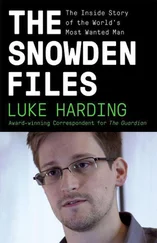Harding, Luke - WikiLeaks - Inside Julian Assange's War on Secrecy
Здесь есть возможность читать онлайн «Harding, Luke - WikiLeaks - Inside Julian Assange's War on Secrecy» весь текст электронной книги совершенно бесплатно (целиком полную версию без сокращений). В некоторых случаях можно слушать аудио, скачать через торрент в формате fb2 и присутствует краткое содержание. Жанр: Старинная литература, на английском языке. Описание произведения, (предисловие) а так же отзывы посетителей доступны на портале библиотеки ЛибКат.
- Название:WikiLeaks: Inside Julian Assange's War on Secrecy
- Автор:
- Жанр:
- Год:неизвестен
- ISBN:нет данных
- Рейтинг книги:3 / 5. Голосов: 1
-
Избранное:Добавить в избранное
- Отзывы:
-
Ваша оценка:
- 60
- 1
- 2
- 3
- 4
- 5
WikiLeaks: Inside Julian Assange's War on Secrecy: краткое содержание, описание и аннотация
Предлагаем к чтению аннотацию, описание, краткое содержание или предисловие (зависит от того, что написал сам автор книги «WikiLeaks: Inside Julian Assange's War on Secrecy»). Если вы не нашли необходимую информацию о книге — напишите в комментариях, мы постараемся отыскать её.
WikiLeaks: Inside Julian Assange's War on Secrecy — читать онлайн бесплатно полную книгу (весь текст) целиком
Ниже представлен текст книги, разбитый по страницам. Система сохранения места последней прочитанной страницы, позволяет с удобством читать онлайн бесплатно книгу «WikiLeaks: Inside Julian Assange's War on Secrecy», без необходимости каждый раз заново искать на чём Вы остановились. Поставьте закладку, и сможете в любой момент перейти на страницу, на которой закончили чтение.
Интервал:
Закладка:
What the paper did not dare advertise, for security reasons, was that the world would shortly be presented with a far bigger trove of leaked documents, detailing similar truths about the bloodbath in Iraq.
CHAPTER 10
The Iraq war logs
Cyberspace
22 October 2010
“ You know we don’t do body counts ”
GENERAL TOMMY FRANKS
The Iraq war logs were all about numbers. Both the US administration and the British prime minister refused to admit how many ordinary Iraqis had been killed since the mixed blessing of their being “liberated” by US and UK troops. General Tommy Franks had notoriously been quoted in 2002 saying, “We don’t do body counts” – a year before he led the US military invasion of Iraq. He may have really meant that he was not going to fall into the over-optimistic trap of the Vietnam war in the 1960s, when US generals had claimed to have slaughtered virtually the entire military manpower of North Vietnam several times over, before admitting eventual defeat.
But because the invasion and occupation of Iraq in 2003 turned into an unplanned bloodbath, “We don’t do body counts” became the unspoken mantra of Bush and Blair as well. Authorities meticulously recorded that 4,748 US and allied troops lost their lives up to Christmas Day 2010. But western governments claimed for years that no other official casualty statistics existed.
The publication of the huge leaked database of Iraqi field reports in October 2010 gave the lie to that. The logs disclosed a detailed incident-by-incident record of at least 66,081 violent deaths of civilians in Iraq since the invasion. This figure, dismaying in itself, was nevertheless only a statistical starting-point. It is far too low. The database begins a year late in 2004, omitting the high casualties of the direct 2003 invasion period itself, and ends on 31 December 2009. Furthermore, the US figures are plainly unreliable in respect of the most sensitive issue – civilian deaths directly caused by their own military activities.
For example, the town of Falluja was the site of two major urban battles in 2004, which reduced the place to near-rubble. Yet no civilian deaths whatever are recorded by the army loggers, apparently on the grounds that they had previously ordered all the inhabitants to leave. Monitors from the unofficial Iraq Body Count group, on the other hand, managed to identify more than 1,200 civilians who died during the Falluja fighting.
In other cases, the US army killed civilians, but wrongly recorded them in the database as enemy combatants. It was as enemy combatants, for example, that the two hapless Reuters employees shot in Baghdad in 2007 by an Apache helicopter gunship – the episode captured on a gun-camera video, and subsequently discovered and leaked to WikiLeaks – were registered.
As so often, further journalistic investigation was needed to improve these raw and statistically dirty figures. Iraq Body Count, an NGO offshoot of the Oxford Research Group and co-founded by a psychology professor, John Sloboda, had dedicated itself for years to counting up otherwise unregarded corpses. They were able to cross-check with the leaked military data. The group says: “The release and publication by WikiLeaks of the ‘Iraq War Logs’ provided IBC with the first large-scale database we could compare and cross-reference with our own. For most of its incidents this military database is as detailed as IBC’s, and quite often more so. Its release in such a highly detailed form enabled us to carry out some preliminary research into the number of casualties that the logs might contain, that have not been reported elsewhere. IBC was consequently able to provide an initial, but fairly robust, estimate that, once fully analysed, the logs would reveal another 15,000 civilian deaths (including 3,000 ordinary police) beyond the previously known death toll.”
The numbers contained in the war logs proved not only to generate that extra 15,000 casualties, but also to be broadly comparable with the IBC’s own unofficial figures. At the end of 2010, IBC concluded that the full total of documented civilian deaths from violence in Iraq since 2003 now ranged between 99,383 and 108,501. The increased confidence that the public can have in these numbers can be presumed to be directly due to the whistleblowing of Manning and Assange, along with the dedication of IBC researchers, and the hard work of journalists from three news organisations. Future historians may be able to assess whether that work might make future American and British military adventures any less reckless and bloody.
Another aspect of the war logs statistics which is likely to be exceptionably reliable – because the US army had no reason to play down the figures – is the appalling total of civilians, local troops and coalition forces whose deaths were caused either by insurgent landmines or by internecine fighting. No fewer than 31,780 deaths were attributed to improvised roadside bombs (IEDs) planted by insurgents. Sectarian killings (recorded as “murders”) claimed another 34,814 victims. Overall, the war logs detailed 109,032 deaths.
This total of dead broke down into the 66,081 civilians detailed above, plus 15,196 members of the Iraqi security forces, and 23,984 people classed as “enemy”. At 31 December 2009, when the leaked database stops, the total was arrived at by the addition of 3,771 dead US and allied soldiers. Every one of those westerners who died had a name, a family and probably often a photograph published in their local newspaper along with grieving tributes. But these files showed they represented less than 3.5% of the real death toll in Iraq.
Such appalling bloodshed was justified by the US, the UK and their occupying partners on the grounds that they had at any rate rescued Iraqis from the brutal police state run by Saddam Hussein. It was therefore doubly disturbing when an analysis of the data by the Guardian ’s Nick Davies revealed that Iraq was still a torture chamber. The legacy being left behind by western troops was of an Iraqi army and police force which would continue to arrest, mistreat and murder its own citizens, almost as if Saddam had never been overthrown.
It was Bradley Manning’s revulsion at the behaviour of the Iraqi police, and US military collusion with it, which had led him, according to statements in his chat logs, to think in 2009 about becoming a whistleblower in the first place. After being rebuffed in an effort to exculpate a group of improperly detained Iraqis, “everything started slipping … I saw things differently … I was actively involved in something that I was completely against.”
Davies reported in the Guardian on 23 October:
US authorities failed to investigate hundreds of reports of abuse, torture, rape and even murder by Iraqi police and soldiers whose conduct appears to be systematic and normally unpunished … The numerous reports of detainee abuse, often supported by medical evidence, describe prisoners shackled, blindfolded and hung by wrists or ankles, and subjected to whipping, punching, kicking or electric shocks. Six reports end with a detainee’s apparent death.
As recently as December 2009 the Americans were passed a video apparently showing Iraqi army officers executing a prisoner in Tal Afar, northern Iraq. The log states: “The footage shows approximately 12 Iraqi army soldiers. Ten IA soldiers were talking to one another while two soldiers held the detainee. The detainee had his hands bound … The footage shows the IA soldiers moving the detainee into the street, pushing him to the ground, punching him and shooting him.” The report named at least one perpetrator and was passed to coalition forces.
In two Iraqi cases postmortems revealed evidence of death by torture. On 27 August 2009 a US medical officer found “bruises and burns as well as visible injuries to the head, arm, torso, legs and neck” on the body of one man claimed by police to have killed himself. On 3 December 2008 another detainee, said by police to have died of “bad kidneys”, was found to have “evidence of some type of unknown surgical procedure on [his] abdomen”.
Читать дальшеИнтервал:
Закладка:
Похожие книги на «WikiLeaks: Inside Julian Assange's War on Secrecy»
Представляем Вашему вниманию похожие книги на «WikiLeaks: Inside Julian Assange's War on Secrecy» списком для выбора. Мы отобрали схожую по названию и смыслу литературу в надежде предоставить читателям больше вариантов отыскать новые, интересные, ещё непрочитанные произведения.
Обсуждение, отзывы о книге «WikiLeaks: Inside Julian Assange's War on Secrecy» и просто собственные мнения читателей. Оставьте ваши комментарии, напишите, что Вы думаете о произведении, его смысле или главных героях. Укажите что конкретно понравилось, а что нет, и почему Вы так считаете.












